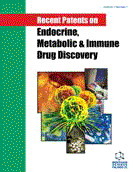Abstract
In addition to their participation in metabolic processes and control of programmed cell death, the role of mitochondria as a fundamental hub for innate anti-viral immunity is now emerging. The participation of the mitochondrial antiviral signaling protein (MAVS) as a central regulator of a complex signaling cascade, which results in the induction of antiviral and inflammatory responses has been described. A patent based on this role of MAVS is highlighted in this review.
Keywords: Immunity, MAVS, mitochondria, viral infection
Recent Patents on Endocrine, Metabolic & Immune Drug Discovery (Discontinued)
Title:MAVS: A New Weapon in the Fight Against Viral Infections
Volume: 7 Issue: 2
Author(s): Jose A. Boga, Maria de Ona, Santiago Melon, Marta E. Alvarez-Arguelles, Ana Morilla and Ana Coto-Montes
Affiliation:
Keywords: Immunity, MAVS, mitochondria, viral infection
Abstract: In addition to their participation in metabolic processes and control of programmed cell death, the role of mitochondria as a fundamental hub for innate anti-viral immunity is now emerging. The participation of the mitochondrial antiviral signaling protein (MAVS) as a central regulator of a complex signaling cascade, which results in the induction of antiviral and inflammatory responses has been described. A patent based on this role of MAVS is highlighted in this review.
Export Options
About this article
Cite this article as:
A. Boga Jose, de Ona Maria, Melon Santiago, E. Alvarez-Arguelles Marta, Morilla Ana and Coto-Montes Ana, MAVS: A New Weapon in the Fight Against Viral Infections, Recent Patents on Endocrine, Metabolic & Immune Drug Discovery (Discontinued) 2013; 7 (2) . https://dx.doi.org/10.2174/1872214811307020004
| DOI https://dx.doi.org/10.2174/1872214811307020004 |
Print ISSN 1872-2148 |
| Publisher Name Bentham Science Publisher |
Online ISSN 2212-3334 |
 24
24Related Articles
-
A Survey on Machine Learning Based Medical Assistive Systems in Current
Oncological Sciences
Current Medical Imaging Drug Nanocarriers and Functional Nanoparticles: Applications in Cancer Therapy
Current Drug Delivery Tamoxifen and its New Derivatives in Cancer Research
Recent Patents on Anti-Cancer Drug Discovery Cancer Treatment-Induced Cardiotoxicity: a Cardiac Stem Cell Disease?
Cardiovascular & Hematological Agents in Medicinal Chemistry Spinophilin: A New Tumor Suppressor at 17q21
Current Molecular Medicine Targeting Malignancies with Disulfiram (Antabuse): Multidrug Resistance, Angiogenesis, and Proteasome
Current Cancer Drug Targets Chemically Synthesized Matrix Metalloproteinase and Angiogenesis-inhibiting Peptides as Anticancer Agents
Anti-Cancer Agents in Medicinal Chemistry The Role of Non-coding Genome in Cancer-associated Fibroblasts; Stateof- the-Art and Perspectives in Cancer Targeted Therapy
Current Drug Targets Diverse Roles of GADD45α in Stress Signaling
Current Protein & Peptide Science Cardioprotection by Targeting the Pool of Resident and Extracardiac Progenitors
Current Drug Targets Adenovirus-Based Cancer Gene Therapy
Current Gene Therapy Gambogic Acid is a Novel Anti-cancer Agent that Inhibits Cell Proliferation, Angiogenesis and Metastasis
Anti-Cancer Agents in Medicinal Chemistry Soy Protein Remnants Digested by Gastro-duodenal Proteases can Alter Microbial Interactions and Intestinal Cholesterol Absorption
Current Proteomics Multifaceted Role of Neuropilins in Cancer
Current Medicinal Chemistry Discovery of Novel HDAC Inhibitors by Structure-based Optimization of Cinnamic Hydroxamic Scaffold
Letters in Drug Design & Discovery Antitumor Activity of Oxali-Titanocene Y in Xenografted CAKI-1 Tumors in Mice
Letters in Drug Design & Discovery The Mechanisms Responsible for Garlic - Drug Interactions and their In Vivo Relevance
Current Drug Metabolism Inhalable Nanostructures for Lung Cancer Treatment: Progress and Challenges
Current Nanomedicine Resveratrol Enhances UVA-Induced DNA Damage in HaCaT Human Keratinocytes
Medicinal Chemistry Breast Cancer and Flavonoids - A Role in Prevention
Current Pharmaceutical Design






















